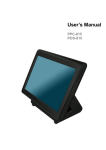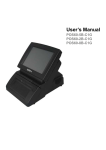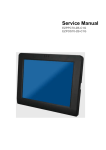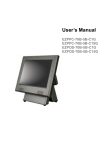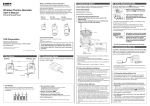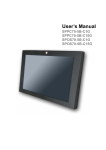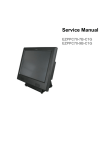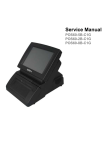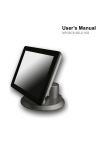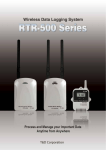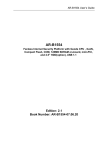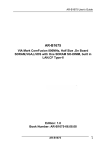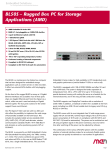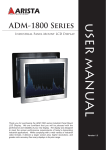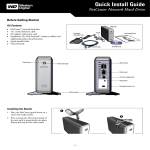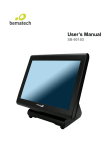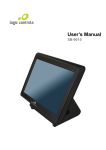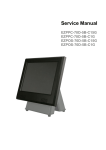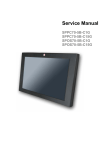Download BOXPC-70-B-C1G User Manual 20080422 4413KB Oct 20 2009
Transcript
User’s Manual BPC70-B-C1G Copyrights The information in this document is subject to change without prior notice in order to improve reliability, design and function and does not represent a commitment on the part of the manufacturer. installation. If this equipment does cause harmful interference to radio or television reception, which can be determined by turning the equipment off and on, the user is encouraged to try to correct the interference by one or more of the following measures: This document contains proprietary information protected by copyright. All rights are reserved. No part of this manual may be reproduced by any mechanical, electronic, or other means in any form without prior written permission of the manufacturer. • Increase the separation between the equipment and the receiver. • Connect the equipment into an outlet on a circuit different from that to which the receiver is connected. • Consult the dealer or an experienced radio or television technician for help. All trademarks are property of their respective This device complies with Part 15 (B) of the FCC Rules. Operation is subject to the following two owners Liability Disclaimer In no event will the manufacturer be liable for direct, indirect, special, incidental, or consequential damages arising out of the use or inability to use the product or documentation, even if advised of the possibility of such damages. Regulatory Information FCC Notices conditions: 1) this device may not cause harmful interference and 2) this device must accept any interference received, including interference that may cause undesired operation. NOTE: THE MANUFACTURER IS NOT RESPONSIBLE FOR ANY RADIO OR TV INTERFERENCE CAUSED BY UNAUTHORIZED MODIFICATIONS TO THIS DEVICE. SUCH MODIFICATIONS COULD VOID THE USER'S AUTHORITY TO OPERATE THE DEVICE. This equipment has been tested and found to comply CE Notice with the limits for a Class B digital device, pursuant to Part 15 of the Federal Communications Commission (FCC) Rules. These limits are designed to provide reasonable protection against harmful interference in This device complies with EMC Directive a residential installation. This equipment generates, 2004/108/EC issued by the Commission of the uses, and can radiate radio frequency energy and, if European Community. not installed and used in accordance with the instructions, may cause harmful interference to radio communications. However, there is no guarantee that interference will not occur in a particular Copyrights i WEEE Notice The WEEE mark applies only to countries within the European Union (EU) and Norway. This appliance is labeled in accordance with European Directive 2002/96/EC concerning waste electrical and electronic equipment (WEEE). The Directive determines the framework for the return and recycling of used appliances as applicable throughout the European Union. This label is applied to various products to indicate that the product is not to be thrown away, but rather reclaimed upon end of life per this Directive. ii Contents Contents Copyrights .................................................................................................i Liability Disclaimer ...................................................................................i Regulatory Information.............................................................................i FCC Notices.......................................................................................................... i CE Notice .............................................................................................................. i WEEE Notice........................................................................................................ ii Contents...................................................................................................iii Introduction ..............................................................................................1 Unpacking the Box...................................................................................2 Hardware Setup........................................................................................3 3.1. Quick Tour .................................................................................................... 4 Front View..................................................................................................... 4 Rear View...................................................................................................... 4 3.2. Peripherals Installation................................................................................ 5 Power Adapter.............................................................................................. 5 USB Mouse, USB Keyboard and USB ODD ............................................... 5 VGA LCD Touchscreen Monitor.................................................................. 5 LVDS LCD Touchscreen Monitor ................................................................ 6 LAN Cable..................................................................................................... 6 Cash Drawer ................................................................................................. 7 Audio Device ................................................................................................ 7 3.3. Turn on the Device ....................................................................................... 7 Driver and Utility Installation ..................................................................8 4.1. Before the installation.................................................................................. 9 4.2. Chipset Software Installation ...................................................................... 9 4.3. VGA Driver Installation ...............................................................................11 4.4. LAN Driver Installation............................................................................... 12 4.5. Audio Driver Installation ............................................................................ 13 Touchscreen Control Panel Quick Guide.............................................14 5.1. Launch Touchscreen V7.3.COM................................................................ 15 5.2. User interface ............................................................................................. 15 5.3. Serial Port Information .............................................................................. 16 5.4. Virtual Button Settings .............................................................................. 16 Virtual Button Option................................................................................. 16 Right Button Function ............................................................................... 17 Right Button Automatic Mode................................................................... 18 5.5. Feedback Sound ........................................................................................ 18 Feedback Sound Option............................................................................ 18 Tone............................................................................................................. 19 Contents iii Duration ...................................................................................................... 19 5.6. Screen Calibration ..................................................................................... 19 4 points, mode 1......................................................................................... 19 4 points, mode 2......................................................................................... 20 How to Use Event Selector........................................................................ 21 I/O Definition...........................................................................................22 6.1. Power Connector ....................................................................................... 23 6.2. Compact Flash Storage Card Socket ....................................................... 23 6.3. Serial Port ................................................................................................... 24 6.4. VGA Connector........................................................................................... 24 6.5. LVDS Connector ......................................................................................... 25 6.6. USB Port Connector .................................................................................. 25 6.7. Cash Drawer Connector (RJ-11) ............................................................... 26 Cash Drawer Control ................................................................................. 26 6.8. LAN Connector (RJ-45).............................................................................. 26 Specification...........................................................................................27 iv Contents 1. Introduction We appreciate and are grateful for your purchasing of the BOXPC series product. BPC-70-B-C1G/BPC-70-B-C15G adopts compact (L210 mm x W189 mm x H62mm), easy assembly/disassembly, modular and fan-less structure design, providing budget and space-saving solution and flexible application. The cost and time of maintenance could be reduced substantially. The I/O interface of BPC-70-B-C1G/ BPC-70-B-C15G is equipped with four COM ports, four USB 2.0 ports and one LVDS connector, which allow you to set up your system as your needs without any hardware limitation. With a Compact Flash II card slot on board, the storage capacity of BPC-70-B-C1G/ BPC-70-B-C15G can be upgraded to 1GB. BPC-70-B-C1G/BPC-70-B-C15G supports most popular Microsoft Windows series operation system (Windows XP Home Edition, Windows XP Professional Edition, WEPOS and Linux, making user spend less effort on technology and software- related issues— so user can devote all energy making your business successful. 1 Chapter 1 2. Unpacking the Box Verify that the box contains the following items. 1 2 3 4 5 6 Chapter 3 The Device X 1 Power Adaptor X 1 Power Cord X 1 Wall Mount Kit X 1 Mounting Accessory Kit X 1 Driver and utility CD X 1 2 3. Hardware Setup 3.1. Quick Tour 3.2. Peripherals Installation 3.3. Turn on the Device 3 Chapter 3 3.1. Quick Tour Front View LED Indicator and Power Switch The Power indicator will glow green when power is on. The HDD indicator will blink green when the HDD is accessed. The LAN indicator will blink green when transferring data though the LAN. Press and hold the power switch until the power indicator on the front panel glow green Rear View Note: For details of I/O ports on the back panel, please refers to . Chapter 3 4 3.2. Peripherals Installation Power Adapter Connect the 4-pin output jack of the adapter to the DC 19V jack on the back panel of the device. USB Mouse, USB Keyboard and USB ODD Connect your USB Mouse, USB Keyboard and USB ODD to USB ports on the back panel of the device. VGA LCD Touchscreen Monitor 1. Connect one end of the Serial Port Cable to the COM male port on the back panel of the device, another end to the COM port of your LCD panel. 5 Chapter 3 2. Connect one end of the VGA cable to the VGA female port on the back panel of the device, another end to the VGA port of your LCD panel. LVDS LCD Touchscreen Monitor Connect one end of the LVDS cable to the LVDS male connector on the back panel of the device, another end to the LVDS end of your LCD panel. LAN Cable Connect one end of RJ-11 LAN cable to the LAN port on the back panel of the device, another end to your internet device. Chapter 3 6 Cash Drawer Connect one end of RJ-45 cable to the Cash Drawer port on the back panel of the device, another end to your cash drawer. Audio Device Connect the phone jack of your audio device to the Audio Out. 3.3. Turn on the Device 1. Make sure all peripherals and power cable are connected properly. 2. Press and hold the power switch until the power indicator on the front panel glow green. 7 Chapter 3 4. Driver and Utility Installation 4.1. Before the installation 4.2. Chipset Software Installation 4.3. VGA Driver Installation 4.4. LAN Driver Installation 4.5. Audio Driver Installation Chapter 4 8 4.1. Before the installation All installation procedures described below are based on Microsoft Windows XP. For CD-ROM onboard model: 1. Insert the driver CD into the onboard CD-ROM drive. The program autoruns and displays the DRIVER BANK screen. 2. Follow the on-screen instructions. For Model without CD-ROM onboard: 1. Connect an external USB CDROM to the USB power and insert the driver CD and turn on the device. The program autoruns and displays the DRIVER BANK screen. 2. Click “EZPOS70 /EZPPC70 /EZBOX70 Series”. 4.2. Chipset Software Installation 1.On the DRIVER BANK screen, click INTEL Chipset Driver. 9 Chapter 4 2. Click Next to go to the next step. 3. After files for installation extracted successfully, click Next to go to the License Agreement. And then click Yes to go to the next step. 4. Read license agreement carefully and click Yes, and then click Next. 5. Installation completed. Select an option to restart computer now or later, and then click Finish. Chapter 4 10 4.3. VGA Driver Installation 1. On the DRIVER BANK screen, click Graphics Driver.. 2. Click VGA Driver for WIN2K/XP. 3. Click Next to go to the next step. After files for installation extracted successfully, click Next to go to the License Agreement. 4. Read license agreement carefully and click Yes to install graphics driver. 11 Chapter 4 5. Installation completed. Select an option to restart computer now or later, and then click Finish. 4.4. LAN Driver Installation 1. On the DRIVER BANK screen, click RTL81x0 LAN Drive. Chapter 4 12 4.5. Audio Driver Installation 1. On the DRIVER BANK screen, click AC’97 Audio Drive and files are extracted automatically. 2. Click Continue Anyway and AC’97 driver start to install. 3. Installation completed. Select an option to restart computer now or later, and then click Finish. 13 Chapter 4 5. Touchscreen Control Panel Quick Guide 5.1. Launch Touchscreen V7.3.COM 5.2. User interface 5.3. Serial Port Information 5.4. Virtual Button Settings 5.5. Feedback Sound 5.6. Screen Calibration Chapter 5 14 5.1. Launch Touchscreen V7.3.COM 1. Under Microsoft Windows XP, click “start” menu and select “Programs”, under ”Touchscreen V7.3.COM” menu, click “Touchscreen Control Panel V7.3.COM”, the control panel of the program shows. 5.2. User interface a b c d e f g h i Serial Port Display serial port information of the system. Virtual Button Open the virtual button setting dialogue box. Feedback Sound Open the feedback sound setting dialogue box. Power Save Open the power down timer adjustment dialogue box Calibration Switch to calibration screen. Calibration Mode Menu Select the calibration by clicking this drop-down list. Display technical support information. Support Exit Exit the program. Event Selector Enable right mouse button function. The default of this selector is with the left mouse button selected on. For details about event selector settings, please see “How to Use Event Selector” of Section 5.2. 15 Chapter 5 5.3. Serial Port Information Click Serial Port button, the serial port information shows. Click OK to back to the control panel. 5.4. Virtual Button Settings Click Virtual Button button, the dialogue box shows: The selected option will be in black. Virtual Button Option Under Virtual Button Option group box, there are four options: ․Stream Mode Under this mode, all mouse button simulation will be disabled. ․Lift off Mode Under Lift off Mode, tapping and holding on the screen equals pressing and holding on the left button of the mouse. Chapter 5 16 ․Touch Down Mode Under Touch Down Mode, one single-tapping equals one left mouse clicking. ․Drag Drop Mode Drag Drop mode allows you to select an object on the screen by tapping, and then slide the selected object to a new location on the screen, the selected object will be dropped on the new location by releasing the touch. The selected option will be in black. Right Button Function ․Disabled (Off) Select this option, the event selector ․Enable (On) Select this option, the event selector the left-bottom corner of the screen. will be disabled and disappear. will be enabled and show on ․Automatic Mode/Manual Mode Drop-down List If the Drag Drop Mode under Virtual Button Option group box is select, the drop-down menu below the Enable (On) option will be enabled. Automatic Mode - Select this option, the Right Button Function will switch to automatic will be disabled and disappear. mode and the event selector Manual Mode - Select this option, the Right Button Function will switch to manual mode and the event selector left-bottom corner of the screen. will be enabled and show on the - Options under Right Button Automatic Mode will be enabled when Manual Mode is selected. The selected option will be in black. 17 Chapter 5 Right Button Automatic Mode Toggle On time is the duration between the tapping on the screen and that the right mouse button is “virtually” pressed and held. Release the tapping from screen after toggle-on, the pop-up menu shows. The minimize value is 0.5 and maximum value is 5. This option defines how long the right button function will be off. The minimize value is 0.5 and maximum value is 5. Click the drop-down menu to select On or Off to enable or disable the beep sound effect for toggle-on and toggle off. 5.5. Feedback Sound Click Feedback Sound button, the dialogue box shows: Feedback Sound Option Silence (No Sound) Chapter 5 18 No any sound effect. Touch Down Only When this option is selected, there will be one “beep” sound when tapping on the screen. Lift Off Only When this option is selected, there will be one “beep” sound when releasing from the screen. Both Touch Down & Lift Off When this option is selected, there will be one “beep” sound when tapping on the screen and releasing from the screen. Tone Drag the bar to adjust the frequency of the sound effect. The minimize value is 200 and maximum value is 5000. Duration Drag the bar to adjust how long the “Beep” sound will be. The minimize value is 10 and maximum value is 50. The selected option will be in black. 5.6. Screen Calibration 1. Click the drop menu next to the Calibration button to select calibration mode. 4 points, mode 1 – rectangular four-point calibration 4 points, mode 2 – rhombic four-point calibration 2. Click Calibration button to enter the calibration screen. 4 points, mode 1 a. The mark shows on the Left-up corner. b. Follow the instruction in green to touch the center of Cross Mark. c. When the instruction turns into yellow, releasing the tapping from the 19 Chapter 5 screen. d. Follow the instruction in green to touch the center of Cross Mark. e. Repeat Step 2 – Step4 to finish the calibration procedure. 4 points, mode 2 a. The mark shows in the middle of the length of the screen. b. Follow the instruction in green to touch the center of Cross Mark. c. When the instruction turns into yellow, releasing the tapping from the screen. d. Follow the instruction in green to touch the center of Cross Mark. e. Repeat Step 2 – Step4 to finish the calibration procedure. 3. When the calibration procedure is completed, the message shows: Chapter 5 20 To save the new calibration, click Yes, to restore the old calibration, click No. How to Use Event Selector 1. On the desktop of Windows, click icon. 2. icon change to . 3. Now the tapping is simulating right mouse button clicking. 4. After one tap on the screen, icon change to 5. The tapping resumes to left mouse button clicking. 21 . Chapter 5 6. I/O Definition 6.1. Power Connector 6.2. Compact Flash Storage Card Socket 6.3. Serial Port 6.4. VGA Connector 6.5. LVDS Connector 6.6. USB Port Connector 6.7. Cash Drawer Connector (RJ-11) 6.8. LAN Connector (RJ-45) Chapter 6 22 Please refer the detailed technical information about all I/O ports as followings. 6.1. Power Connector PIN Description PIN Description 1 GROUND 3 +12V 2 GROUND 4 +5V 6.2. Compact Flash Storage Card Socket PIN Description PIN Description PIN Description PIN Description PIN Description 1 GROUND 11 N/C 21 D0 31 D15 41 RESET# 2 D3 12 N/C 22 D1 32 CS3# 42 IORDY 3 D4 13 VCC 23 D2 33 N/C 43 N/C 4 D5 14 N/C 24 34 IOR# 44 N/C 5 D6 15 N/C 25 35 IOW# 45 ACTIVE# 6 D7 16 N/C 26 36 PDIAG# CS1# 17 N/C 27 37 OBLIGATORY TO PULL HIGH IRQ15 46 7 N/C CARD DETECT2 CARD DETECT1 D11 47 D8 8 N/C 18 A2 28 D12 38 VCC 48 D9 9 GROUND 19 A1 29 D13 39 MASTER/SLAVE 49 D10 10 N/C 20 A0 30 D14 40 N/C 50 GROUND 23 Chapter 6 6.3. Serial Port COM Port 1/2/3/4 PIN Description PIN Description 1 RED 6 GROUND 2 DDCDAT 7 HSYNC 3 GREEN 8 GROUND 4 DDCCLK 9 VSYNC 5 BLUE 6.4. VGA Connector Chapter 6 PIN Description PIN Description 1 RED 9 N/C 2 GREEN 10 Sync GND 3 BLUE 11 Ground 4 Ground 12 SDA;DDC 1/2B 5 DDC-GND 13 Horizontal Sync 6 Red GND 14 Vertical Sync 7 Green GND 15 SCL DDC 2B 8 Blue GND 24 6.5. LVDS Connector 6.6. USB Port Connector The system provides 4 built-in USB2.0 ports for new I/O bus expansion. PIN 25 Description PIN Description 1 USB bus-powered 3 USB differential signal 2 USB differential signal 4 Ground Chapter 6 6.7. Cash Drawer Connector (RJ-11) PIN Description PIN Description 1 GROUND 4 DOUT_0 2 DIN_0 5 +12 V 3 N.C 6 GROUND Cash Drawer Control Status Address Value Open 280H Bit 4 = 0 Close 280H Bit 4 = 1 Read Status 281H Bit 0 = 0/1 6.8. LAN Connector (RJ-45) PIN Chapter 6 Description PIN Description 1 Transmit Out + 5 No Connection 2 Transmit Out - 6 Receive In - 3 Receive In + 7 No Connection 4 No Connection 8 No Connection 26 7. Specification 27 Chapter 7 Main Board CPU Intel Ultra Lo Voltage Celeron M 1GHz w/o L2 cache Chipset Intel 852GM + ICH4 System Memory SO-DIMM DDR 200/266, 128MB up to 1GB Thermal Solution Fan-less OS Microsoft Windows XP Professional, XPE, WEPOS, Windows CE, Linux Storage Device HDD 1 x IDE, 2.5” HDD Drive Bay Compact Flash 1 x Slot Compact Flash Type II I/O Ports Serial 5 x RS-232, 1 x RS-232/422/485 COM1: DB-9, RS-232/422/485, Pin9 w/ RI/5V/12V Selectable by BIOS COM2/3/4: DB-9, RS-232, Pin9 w/ RI/5V/12V Selectable by BIOS COM5: Internal Pin Header COM6: Internal for Touch Panel USB 4 x USB 2.0 LAN 1 x Gigabit Ethernet by RJ-45 Cash Drawer 1 x RJ11 (12V DC) Audio AC’ 97 2.0 Compliant, VGA 1 x DB-15 SCSI Combination interface of LVDS, RS-232, Power (3.3V, 5V, 12V) and LED Others Power Input External Adapter, 90W, 19VDC Input Compliance FCC / CE Weight (Kgs) 2.4 Dimension 210(W) x 189(D) x 62(H) mm Operating Temperature 5 – 40 Degree Storage Temperature -20 – 60 Degree Storage Humidity 20 – 85% RH, non-condensing Order Information BPC70-B-C1G Fan-Less BOX PC with Intel ULV Celeron 1GHz CPU Options Please refers to the Spare Part List of BPC70-B-C1G Chapter 7 28

































